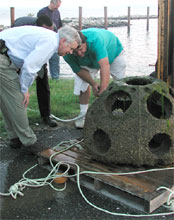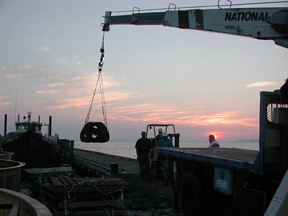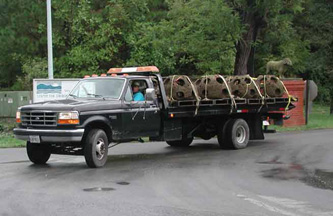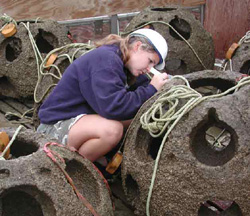 |
University
of Maryland Center for Environmental Science
UMCES
HELPS STATE TO FILL MEMORIAL STADIUM
WITH "MARYLANDERS"
ONCE MORE Summer and Fall,
2002 | 
|
 
 
HORN POINT, Md. -- During
the summer and fall of 2002 UMCES researchers teamed with
private and state agencies to create the 6-acre Memorial
Stadium Oyster Reef Sanctuary, created with rubble from Baltimore's
famous arena. An innovative oyster reef restoration
project, it was a joint project among the Center, private and
state agencies and was aimed at restoring oyster in the upper
Chesapeake Bay where oyster reefs were once
abundant.
For the Memorial Stadium project, Dr. Donald
"Mutt" Meritt and Horn
Point Laboratory Shellfish Culture Facility technicians at
UMCES were charged with populating 14
concrete reef balls designed for the project with oyster
spat. Reef balls are commonly used in coral reef restoration
but this project was the first time they were used for oyster
spat. Using more than 20 million oyster larvae, the reef balls
were set at the culture facility for a week before being
transported into the lab's nursery in the Choptank River, done
with the assistance of the Oyster Recovery
Partnership.
On October 3, the reef balls along
with 10,000 cubic yards of rubble were planted at the reef
site, three miles of Tolchester beach in Kent
County.
This project was one of over 15 oyster
restoration projects created in 2002 that utilized the over 73
million oyster spat produced in 2002 at the Center's culture
facility. The shellfish culture facility at Horn Point in a
cooperative partnership with the Oyster Recovery Partnership
produces more than 90 percent of all culture-produced oyster
spat in the state. Oyster larvae and spat produced in this
facility are used to support the University's research,
education, and outreach programs and is a major contributor to
culture-based oyster restoration projects around
Maryland.
Partners in the Memorial Stadium Oyster Reef
project include: Maryland Environmental
Service, Maryland
Department of Natural Resources, Maryland Department of the
Environment, Maryland
Saltwater Sportfisherman’s Association, Coastal Conservation
Association, Oyster Recovery
Partnership, NOAA Chesapeake Bay office, Maryland Watermen’s
Association, U.S.
Army Corps of Engineers, UMCES and
others.


BACK TO MAIN
PAGE | |
| |

